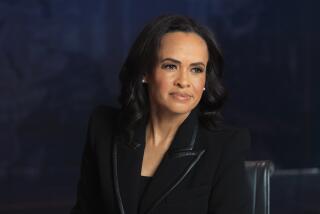ABC News’ Diane Sawyer gamble pays off
- Share via
Quietly taking over as anchor from Charles Gibson at “ ABC World News” at the end of last year, Diane Sawyer brought with her not only an impressive résumé, an excellent name-recognition rating and some pretty cool new graphics, but also a remarkably counterintuitive manner.
In a world dominated by YouTube moments and professional hysterics, Sawyer exudes an alarming level of elegance. From the moment she opened her show -- “Good evening, and it is so good to be here with you tonight” -- it was clear that she was not going to so much report the news as preside over a series of conversations about the news, conversations she simply must share with you, her personally invited viewer.
And if ratings are any indication, Sawyer may be able to succeed where Katie Couric hasn’t quite, blending the undeniable if troubling trend toward emo-journalism while still commanding the gravitas necessary for a serious news organization. (Both trail NBC News’ Brian Williams in the ratings.)
If nothing else, Sawyer’s early success proves that Americans are not as disgusted with the media, or cultural, elite as they seem -- from the moment she left her memoir-writing job with former President Nixon to become the first female host of “ 60 Minutes,” Sawyer, with her patrician good looks, has been groomed to be a star.
Even so, the folks at ABC were taking a bit of a gamble when they hired Sawyer to compete with Couric at CBS. While the two share a gender and some job history similarities -- Couric still contributes pieces as a correspondent on “60 Minutes” and both came off successful morning show runs -- they are in tone and mien as different as night and day, or Anderson Cooper and Wolf Blitzer.
Given to laughter and wide, dazzling smiles, Couric is 12 years younger than Sawyer and trades on a high-energy likability often characterized as perkiness, a word no thinking person would ever use to describe Sawyer. Where Couric has developed a brand of bouncy determination, a seasoned extension of the intrepid girl reporter, Sawyer has always been the Katharine Hepburnofthe newsroom, classy in white collared shirts, radiating a passionate but still clearly intellectual concern for what is happening in the world around her.
Certainly during her first month in the big chair she’s had reason to be concerned -- the Christmas bombing attempt, the healthcare crisis, the earthquake in Haiti, the upset in Massachusetts all demanded of its television reporters and newscasters a heightened sense of urgency, sorrow and exasperation, which Sawyer is well-equipped to deliver. Interviewing President Obama, she used the manner of a worried friend and sympathetic fellow public figure to soften the audacity of asking him, “With all this coming at you, have you ever thought that one term might be enough?” (A question the equally socially flexible president handled with ease and did not, of course, answer.)
It doesn’t always work perfectly. Even when she’s reporting good or funny news -- the crime rate is down, men are now marrying for money -- Sawyer appears troubled by what she’s having to tell you. She’s a big head-bobber, with a slightly sideways approach to the camera that she may have borrowed from the late Lady Diana, and though she never actually frowns (one suspects her forehead has lost the physical ability to actually frown), she often seems to be frowning. Her eyes crinkle up and her lovely alto voice climbs a bit just to let viewers know that she is not just a heartless newscaster reporting the news but also a fellow citizen reacting to it.
That is, of course, part of the current job description. The granite jaws and unflappable stoicism that make Walter Cronkite and Eric Sevareid giants doesn’t play so well these days. We want our newscasters, even our big-time newscasters, more accessible and conversational, still objective, of course, but asking questions that we might ask ourselves, rather than working off some inflexible template acquired at journalism school.
If the news is bad, or frustrating, or puzzling, we want them to show that too. It isn’t enough to ask the White House correspondent how Congress is reacting to the Republican victory in the Massachusetts Senate race and leave it at that. A good TV anchor nowadays is like a high-powered hostess, perpetually drawing conversation from some well informed but possibly shy guest -- of course, Capitol Hill is in a dither and the president must be beside himself, but you’re right there. What on Earth are people saying?
Sadly enough, this shift in tone is why we finally have two women hosting the nightly news. (Well, that and Oprah Winfrey, who is responsible for so many shifts in popular culture.) Women are still perceived as being, in general, more emotional, more conversational than men (and woe to the woman who, like Hillary Clinton, does not conform). Increasingly, we expect a kitchen-table tone to our news, an intimacy that a generation ago would have been considered too domestic to be smart.
Not that Sawyer is domestic, far from it. She may be conversational, but in a way far more White House dinner party than kitchen table.
With her classic features and low-pitched voice, she emanates an intellectual pedigree that she actually possesses -- Sawyer has indeed covered wars and interviewed most living heads of state, she is married to director Mike Nichols, she does hang out with Meryl Streep. A living, breathing member of the much-derided media elite, Sawyer still tries her best to seem like one of us, her voice near breaking as she stands on the tarmac in Port-au-Prince wondering when someone was going to actually deliver all that food and water to the Haitians.
She isn’t one of us, of course; the Everywoman points all go to Couric, which is what makes Sawyer’s higher ratings so interesting. Like Cooper, Sawyer is smart and seemingly sincere but sleek too, removed from the mainstream by her own physical perfection and gilded life.
In studio interviews especially, Sawyer often appears almost incandescent, bathed in a golden light achieved, one supposes, by precise placement of reflective panels and the miracle of digital technology. Like all superstar journalists, she is, at best, an equal draw to her one-on-one interviews and at worst, she outshines her subject, which may have been OK on “Good Morning America” but is a bit more alarming on the nightly “World News.”
All of which makes Sawyer a fascinating bridge between the new world order and the old. If nothing else, she is a striking and welcome contrast to the often instantly constructed personalities of younger newscasters -- she hasn’t changed much since her days at “60 Minutes” and it seems to be working just fine.
Amid all the fear and messiness as the old media surrender, spitting and flailing, to the new, Diane Sawyer is a beacon, proof that you do not always have to stoop to conquer.
mary.mcnamara @latimes.com
More to Read
The biggest entertainment stories
Get our big stories about Hollywood, film, television, music, arts, culture and more right in your inbox as soon as they publish.
You may occasionally receive promotional content from the Los Angeles Times.











